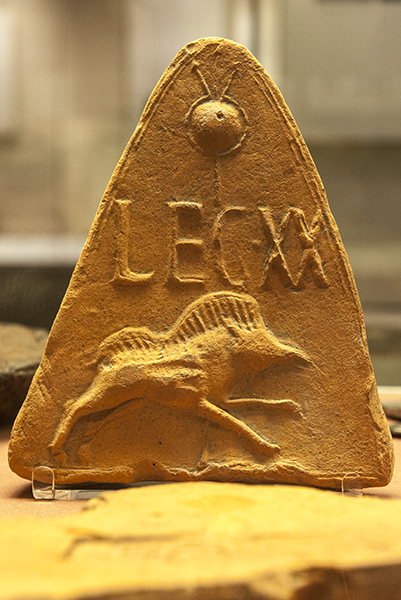

“the Twentieth, called both Valeria and Victrix, in Upper Britain. All these I believe, were the troops which Augustus took over and kept, together with the legion known as the Twenty-Second, which is quartered in Germany. The legion I have entitled Valeria is not given this name by all, and in fact no longer uses that designation. At any rate these are the legions which are still in service today, out of those maintained by Augustus himself and by other emperors, in consequence of which such legions have come to bear the name Gemina.”
Cassius Dio, Roman History (LV.23.6–7)
The Twentieth Legion was one of four (II Augusta, IX Hispana, XIV Gemina, XX Valeria) that took part in the invasion of Britain in AD 43. Based at Colchester, it was transferred in AD 49 to a site near Glevum (Gloucester) to help put down the Welsh tribes. The abandoned legionary fortress then became the foundation for Colonia Claudia, the first provincial capital of Britannia. Legio XX subsequently played an important role in the campaigns of Agricola and finally was stationed at Deva (Chester). The legionary emblem (above) was a charging wild boar, as can be seen in this antefixa (decorative gable end) in the British Museum.
The passage from Dio is the first mention of the cognomina of Legio XX, which has been a source of some scholarly disagreement. One opinion holds that the honorific has two parts, one (Valeria) derived from the family name of Valerius Messalinus, under whose command Legio XX gained distinction in suppressing the revolt of the Pannonians and Dalmatians in AD 6-9, the other (Victrix) awarded for victory in the Boudican revolt of AD 60/61.
McPake argues against the notion that Legio XX acquired its title in honor of its commander. It would have been the only legion to have done so and, presumably, its honorific would have appeared on at least one other inscription in the more than half a century that followed. Yet, of all those that mention the Twentieth Legion, there is no epigraphic evidence datable before AD 60 that shows any indication of a cognomen. Only in inscriptions from the late first century AD do the initial letters VV or Val Vic begin to appear.
Rather, McPake contends, Valeria is derived from valeo (which the Oxford Latin Dictionary defines as “to possess, or have predominance in, military or political power, resources, etc.”) and personifies its qualities of strength and well-being, luck and good omen, in much the same way that Martia represents the warlike qualities of Mars. Nor was Legio XX the only military unit to hold this title. Cohors I Breucorum also was known as Valeria Victrix, which must have been given that title quite independently of a commander called Valerius or events in Britain. Legio XX had no cognomen apart from its double honorific, which was awarded only after the Boudican revolt, at the same time and for the same reason, one suspects, that Legio XIV Gemina was similarly recognized with the title Martia Victrix.
Reference: "A Note on the Cognomina of Legio XX" (1981) by R. McPake, Britannia, 12, 293-295.